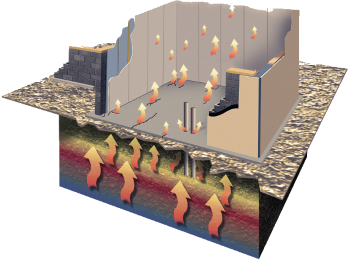Vapor Intrusion

What Is Vapor Intrusion?
Vapor intrusion occurs when volatile chemicals from contaminated groundwater and/or soil are present below a building. These chemicals can produce vapors that migrate through the subsurface and into indoor air spaces.
In some cases, the vapors can accumulate within the building and increase to levels that may pose a health and safety risk. According to the EPA, testing for vapor intrusion can be challenging due to the potential presence of some of the very same chemicals within the building– therefore making it challenging to determine the source of chemical emission.
Vapor Intrusion Mitigation Techniques
When mitigating vapor intrusion, there are a number of viable techniques which differ in both their approach and long-term effectiveness, These approaches include
- Source Remediation – removing the actual contaminated soil/groundwater will eventually eliminate vapor intrusion
- Vapor Intrusion Barriers – installing a physical, chemical resistant barrier material to seal off exposure pathways. The use of a vapor collection system can be used in conjunction to alleviate the buildup of contaminated vapors underneath the building.
- Ventilation Systems – installing a ventilation and exhaust system to remove the contaminated air from within or beneath the building. Forced or mechanical ventilation may be accomplished by using a fan to blow air into or out of the building.
Land Science
Land Science® is dedicated to developing and providing advanced technologies for sustainable land development. A goal of Land Science is to provide innovative and technically sound development solutions for under-utilized environmentally impaired properties, commonly referred to as Brownfields. Land Science’s cost-effective, industry leading technologies offer engineering firms and real estate developers solutions to issues facing the development of Brownfields today.
FAQs about Enhanced Aerobic Biodegradation
Chemical vapors from contaminated soil and groundwater can move into nearby buildings through cracks in the concrete foundation, gaps around utility lines, or sumps. Vapors can also move through concrete, which is naturally porous. These vapors can cause both immediate and long-term health risks for building occupants and, in some cases, be an explosive hazard. By preventing the entry of vapors either actively (i.e. inducing pressure differentials) or passively (i.e sealing cracks in the floor slab), the harmful effects of vapor intrusion can reduced.
Mitigation of vapor intrusion is necessary for as long as there is a health risk to building occupants. Oftentimes, mitigation is employed as an interim measure until soil and groundwater remediation is complete, which can take months to years.
Vapor intrusion mitigation systems are quite safe and will serve only to improve indoor air quality. They should remain in place until the source of chemical vapors is removed and should undergo regular inspection to ensure they are still working properly.

 Americas
Americas Europe
Europe Français
Français Deutsch
Deutsch Italiano
Italiano Español
Español


